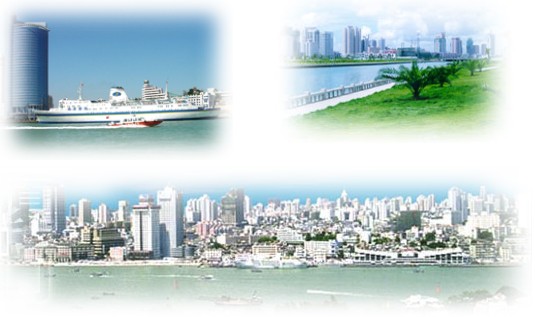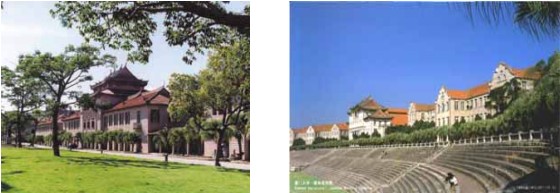﹞Introduction
to Xiamen City:
﹛﹛Xiamen, also known as Amoy,
is the historical harbor city in the southeastern part
of China. In 2004 the city won the finals of the world*s
Human Settlements and Environment Award, ※Nations in
Bloom§. Xiamen attracts a large number of foreign and
local tourists. The city is easily accessible by air,
and there are direct flights from Hong Kong, Kuala Lumpur,
Osaka, Seoul, Singapore and Tokyo. Within China, Xiamen
airport is linked to more than 30 domestic airports.

﹞Introduction to Xiamen University:
﹛﹛The 3-day Symposium will be
held in Xiamen University on Xiamen Island. The campus
is located in a picturesque setting between the sea
and a scenic mountain. The University, the premier university
in Fujian Province, has a student number of over 200,000
and just celebrated its 83th anniversary. The campus
is spread over 150 hectares, and all buildings and facilities
are within walking distance.

﹞Sightseeing possibilities:
APP-1 Horticultural and Botanical Garden 每 &Ten Thousand Rocks
Hill*.
 The scenic zone presents a picturesque and charming view full of special nature*s delight. The botanical
garden boasts over 4,000 kinds of tropical and subtropical plants. The exotic rocks in different shapes create various associations
with a lasting appeal.
The scenic zone presents a picturesque and charming view full of special nature*s delight. The botanical
garden boasts over 4,000 kinds of tropical and subtropical plants. The exotic rocks in different shapes create various associations
with a lasting appeal.
App-2 Old Fortress and Buddhist Monastery 每 Nanputuo Temple with Special Vegetarian Lunch
 Nanputuo Temple exhibits the historic origin and cultural traits of our Eastern nation. Built in the Tang
Dynasty (9th century), the temple seems to be towering in the mountains to show its impressively solemn and splendid architecture.
A special vegetarian lunch will be arranged in the Buddhist restaurant inside the Temple. For centuries, Xiamen has been an
important outpost of coastal defense in southeast China. The Hulishan Old Fortress was a military position built in 1823 in Qing
Dynasty.
Nanputuo Temple exhibits the historic origin and cultural traits of our Eastern nation. Built in the Tang
Dynasty (9th century), the temple seems to be towering in the mountains to show its impressively solemn and splendid architecture.
A special vegetarian lunch will be arranged in the Buddhist restaurant inside the Temple. For centuries, Xiamen has been an
important outpost of coastal defense in southeast China. The Hulishan Old Fortress was a military position built in 1823 in Qing
Dynasty.
App-3 Jimei School Village Tour
 Jimei Town, 17 kilometers from Xiamen city covers an area of 2.83 square kilometers. In 1913, Tan Kah Kee, famous overseas Chinese,
established Jimei School Village, which can be regarded as an epitome of China*s educational system. It is also a special
sightseeing area, presenting various sites including ※Fujian*s Stone Carving Museum§.
Jimei Town, 17 kilometers from Xiamen city covers an area of 2.83 square kilometers. In 1913, Tan Kah Kee, famous overseas Chinese,
established Jimei School Village, which can be regarded as an epitome of China*s educational system. It is also a special
sightseeing area, presenting various sites including ※Fujian*s Stone Carving Museum§.
﹞APP-4 Gulang Island
 A mere 500 meters as the fly flies across the harbor from downtown Xiamen lies the famous 1.77 square kilometer island of
Gulang Island (or "Drum Waves§, because the breakers pound the rocks like drums). Gulangyu Island possesses one asset almost
unheard of elsewhere in China: quietness! Vehicles and bicycles are forbidden on the tiny island. The only sound you will hear on
Gulangyu Island is pianos. This tiny community of 20,000 has more pianos per capita than anywhere else on the planet, hence
Gulangyu Island`s nickname is "Piano Island."
A mere 500 meters as the fly flies across the harbor from downtown Xiamen lies the famous 1.77 square kilometer island of
Gulang Island (or "Drum Waves§, because the breakers pound the rocks like drums). Gulangyu Island possesses one asset almost
unheard of elsewhere in China: quietness! Vehicles and bicycles are forbidden on the tiny island. The only sound you will hear on
Gulangyu Island is pianos. This tiny community of 20,000 has more pianos per capita than anywhere else on the planet, hence
Gulangyu Island`s nickname is "Piano Island."
﹞App-5 Shopping
 Located throughout the city are tax-free department stores, supermarkets, shopping centers and markets for daily commodities.
Xiamen is a place for shopping at your convenience.
Located throughout the city are tax-free department stores, supermarkets, shopping centers and markets for daily commodities.
Xiamen is a place for shopping at your convenience.
﹞Travel Information :
﹛﹛Xiamen International Airport
is one of four leading international airports in China
with excellent services and first-rate facilities. It
has 57 air lines to and from places at home and abroad.
It has direct flights to and from Hong Kong, Macao,
Singapore, the Philippines, Malaysia, and Japan. However,
the most convenient international transition would be
in Shanghai, Hong Kong or Guangzhou (60-80 minute flight
to Xiamen).
﹞Travel procedures:
﹛﹛Air travel to Xiamen. Please identify and prepare
your own preferred travel itinerary for air travel to
Xiamen. Once you have done this, please email the information
about your selected flights to Lillie Wicher ( lwicher@lumcon.edu
) and she will make your flight reservations for you
and pay for your tickets directly. Please do not make
your own flight reservations because it will be impossible
to reimburse you for air travel after the symposium
is complete. If you have any questions about air travel
procedures, please contact Michael Dagg (mdagg@lumcon.edu
)
﹛﹛Transportation from Xiamen International Airport:
1. By taxi: Travel by taxi is the most convenient method.
The fare is RMBㄓ 50-60 (about US$ 6.00 - 7.50) from
Xiamen International Airport to Xiamen University.
2. By airport shuttle bus: Take the shuttle bus at the
airport and get off at the Xiamen Railway Station bus
stop [the fare to Xiamen Railway Station bus stop is
RMBㄓ 5 (about US$ 0.80)], then by taxi (RMBㄓ 15-20,
about US$ 2.00-2.50) to Xiamen University]. The Shuttle
bus service runs from 7:00 to 21:00 daily.
﹞ How
to reach Lujiang Hotel
﹛- Transportation from Xiamen
International Airport to Lujiang Hotel will be arranged
as far the local organizer knows your arrival dates
and times. Other options are:
﹛1. By taxi: Travel by taxi is the most convenient method.
The fare is RMBㄓ 50-60 (about US$ 6.00 -7.50) from Xiamen
International Airport to Lujiang Hotel.
﹛2. By airport shuttle bus: Take the shuttle bus at
the airport and get off at the Xiamen Railway Station
bus stop [the fare to Xiamen Railway Station bus stop
is RMBㄓ 5 (about US$ 0.80)], then by taxi (RMBㄓ 15-20,
about US $2.00-2.50) to Lujiang Hotel. The Shuttle bus
service runs from 7:00 to 21:00 daily.
﹞Electricity :
﹛﹛220 Volts 50 Hz throughout
the country.
﹞Climate and Clothing
August and September is the Summer
Season in Xiamen with average temperatures between 28
每 32∼ C. The Conference site, hotels, taxies, shuttle
buses, most of shops and some buses are well air-conditioned.
Participants are advised to bring along light clothing.
No formal dress will be required for any of the functions
including the Conference Banquet.
|